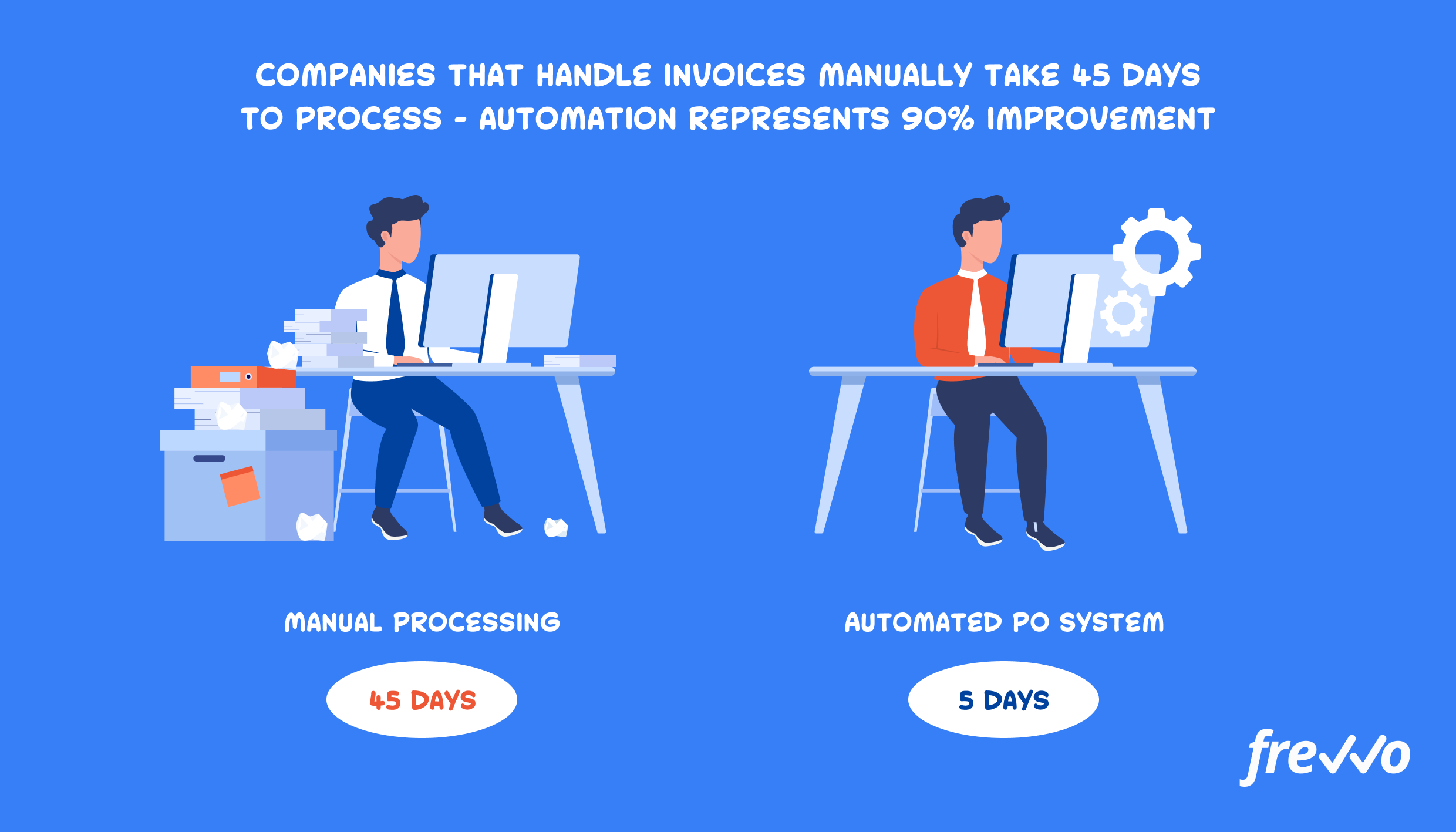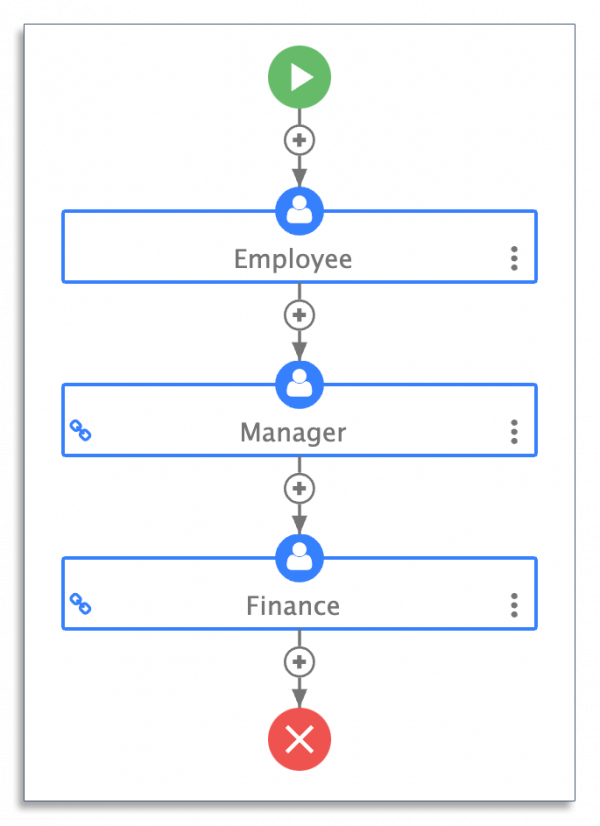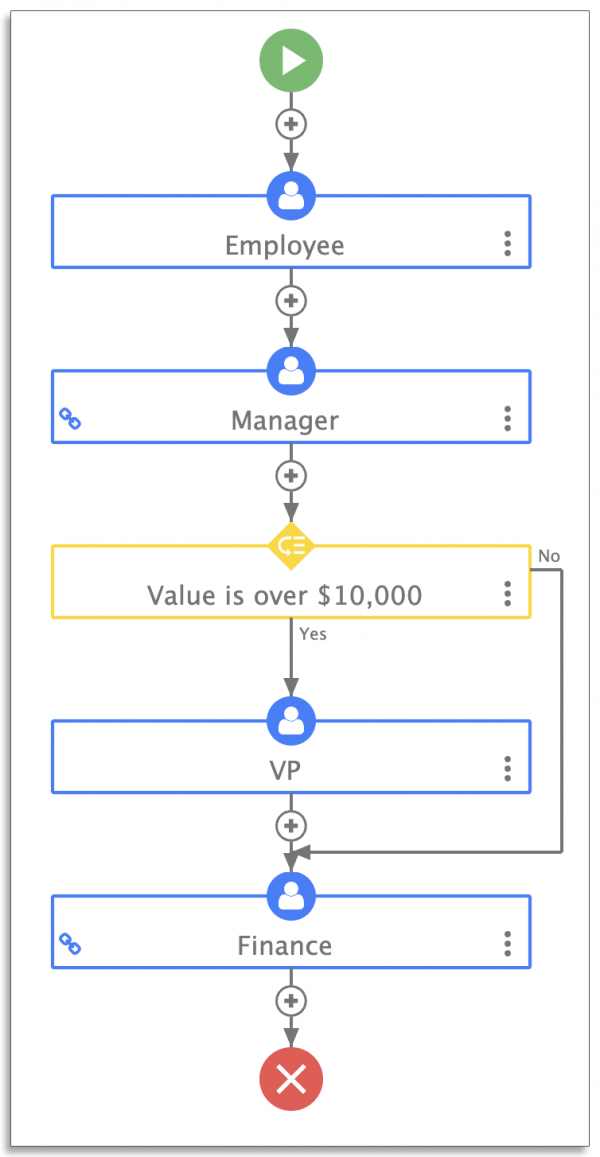Purchase orders play an important role in the procurement process. They allow companies to place orders with different suppliers and manage their inventory.
Most importantly, purchase orders serve as written agreements that include details about goods, quantities, prices, and delivery dates.
No matter what goods or services you purchase, you need a way to track those orders.
A paper-based purchase order process can work. But as your company grows, managing all the paperwork becomes a hassle and can slow down procurement.
So how can you create a more efficient purchase order process?
Using a purchase order (PO) system can help.
If you’re still managing purchase orders manually and are looking for a way to streamline this process, then keep reading.
In this article, we’ll walk you through what a PO system is, why your business needs one, and how you can set one up using frevvo’s purchase order workflow software.
Modern low-code platforms are so easy to use that you don’t need an army of expensive developers or a large I.T. budget. The interface is fully visual, so if you know how to use Excel then you can create your own automated workflows.
Click the links below to jump to the section you want to learn more about:
- What Is a Purchase Order System?
- Benefits of an Automated PO System
- How to Set Up an Automated PO System in 5 steps
What Is a Purchase Order System?
A purchase order system is software that helps you create, manage, and track purchase orders that you send to your vendors. It allows you to scale and automate the entire procurement process.
Purchase orders are part of the procurement process. The workflow varies for every company depending on their requirements, but it generally follows the same steps.
Here’s an example of a purchase order workflow:

The PO process starts with an employee creating a PO and ends when your company pays the invoice and enters the transaction in your records.
Many companies in the early stages may forego purchase orders and enter into informal agreements with their suppliers. Informal processes are convenient, but what if there’s a dispute about payment or delivery terms?
Things can get complicated without proper documentation.
Having a formalized PO system enables you to create purchase orders, manage vendor information, and approve invoices from one place.
Purchase orders are legally binding once signed and accepted, so they provide legal protection. If there’s a dispute from either side, you’ll have a record of the agreed-upon terms in your PO system.
A paper-based purchase order system is better than no system at all. But relying on a manual process is costly and inefficient. It’s also prone to errors — an employee may duplicate an existing PO, enter in the wrong data, or forget to route a document.
Let’s take a look at how an automated PO system can address these challenges and improve purchase order management and how even a small business with limited I.T. resources can implement one.
Benefits of an Automated PO System
Managing purchase orders manually just isn’t practical in the long run, especially as you start to process more purchase orders and work with more vendors.
You’ll save yourself (and your employees) a lot of time and effort when you use purchase order workflow software like frevvo to automate the process.
Here’s how an automated purchasing system can streamline the procurement process.
Increases Productivity
Each minute an employee spends manually preparing a purchase order is time they could spend on more productive tasks like negotiating better contracts or, better yet, improving the customer experience.
The increased risk of entering data incorrectly or making a calculation error also means spending even more time to correct those mistakes.
An automated PO system can help you streamline the entire purchasing process. Employees won’t have to waste their time filling out the same forms or chasing signatures for approvals.
Lowers Processing Costs
Manually processing purchase orders means longer cycle times — the time it takes to create and deliver a PO to a vendor or supplier.
Companies with an automated PO system have an average cycle time of 24 hours, while those that rely on manual methods take 35 hours.

Higher cycle times mean higher processing costs.
Using a PO system to reduce cycle times can help you lower processing costs. Ways to do so include reducing manual data entry and automatically routing POs to vendors.
Improves Cash Flow Management
A healthy cash flow puts your company in a better position to meet your financial obligations and sustain operations. However, 44% of small business owners who had cash flow issues said the problems came as a surprise.
A PO system gives you full visibility into upcoming financial commitments. Accounting teams can analyze previous orders and anticipate future spending. They can also plan accordingly to ensure there are sufficient funds to cover incoming invoices.
When you know how much money is available, you can plan your budget more effectively and avoid cash flow surprises without having to go through a trail of paper forms.
Helps Reduce Errors and Prevent Fraud
Manual processes are more prone to errors. Instances of overpayments, inaccurate deliveries, and even fraud are likely to occur when purchasing controls are lax.
Using frevvo’s purchasing software can help you implement strict internal controls and enforce adherence to internal policies to reduce errors.
Examples include setting controls on who can start a workflow and requiring signatures. You can even create a rule that routes POs above a certain value to a senior executive for additional review.
If an error does occur, a PO system creates an audit trail that shows what actions were taken, who performed them, and when. With these insights, you can take steps to create a process improvement plan and eliminate inefficiencies.
Improves Vendor Relationships
Companies that handle invoices manually take 45 days to process invoices, while those that use automated approval workflows take just five days on average.

A PO system doesn’t stop at creating and approving purchase orders. You can also integrate it with your accounting software and set it up to pay invoices in a timely manner.
By streamlining the invoice approval process, you can improve relationships with your vendors and even take advantage of early payment discounts.
Some vendors offer 2/10 net 30 payment terms. If you pay an invoice in full within 30 days, you can get a 2% discount on the net amount, which can translate to huge savings in the long run.
Now let’s look at how you can set up an automated PO system.
How to Set Up an Automated PO System in 5 Steps
Even if you’re a small business with a limited budget and I.T. resources, you can still set up a fully automated PO system and streamline the procurement process.
With frevvo’s purchase order workflow software, you get the benefits of an enterprise-grade system with audit trails, hardened security, built-in ADA and WCAG compliance, and more.
The best part? There’s no need to code or spend significant resources.
Follow these steps to get started.
1. Start With a Pre-Built Template or Use the Workflow Wizard
As your company starts processing more purchase orders, you simply can’t afford to lose months of development time to create a custom solution.
frevvo’s purchasing software lets you set up an automated PO system in a matter of days or even hours. Get started by selecting a pre-built template — each comes with an automated workflow and form that you can use right away.
Here’s an example of a purchase order workflow that you can install:

The workflow starts when an employee creates a purchase order. Then it routes to a manager for review and then routes to the finance department for final approval before it gets sent to a supplier. You can start with this template and add or modify individual steps.
Want to create your own fully customized PO workflow?
Use the Workflow Wizard to build a custom workflow from scratch. Add and configure as many steps as you need to create a workflow that fits your purchasing process.

The purchasing process can vary from one organization to another. Ensure that you understand what each step involves, including who is responsible for them when creating an approval workflow.
Use this opportunity to perform a business process analysis and identify any redundancies or inefficiencies in your PO process.
Give each step a meaningful name and describe who works on it, and frevvo will automatically generate a workflow that contains routing and a basic form.
2. Customize Your PO Forms and Add Business Logic
The next step to setting up an automated PO system is to create an electronic purchase order form.
Purchase orders typically include the following:
- Contact information
- PO number
- Date
- Item descriptions
- Quantity and prices
- Payment information
- Expected delivery

These items can vary depending on your company’s procurement requirements. But it’s a good idea to create a standardized PO form for consistency.
Here’s an example of a purchase order form that comes with the pre-built template:

With the visual drag-and-drop builder, you can add text fields, dropdown lists, checkboxes, and more to customize your form to fit your business requirements.
That’s not all.
Forms are more powerful when you add dynamic behavior to them. For example, fixing simple errors or sending forms back because of missing information creates unnecessary delays.
frevvo’s purchase order system comes with a visual rule builder that lets you add business rules to your forms — no coding required.
Here are some things you can do with business rules:
- Pre-populate fields based on the logged-in user
- Calculate totals and subtotals automatically
- Specify custom formats for fields
- Make fields (like signatures) required
- Show or hide form controls like text areas
Here’s an example of how you can use the rule builder to add business logic:

With the workflow builder, you can add or modify steps, customize notifications and other messages, and also add conditional routing to your PO process. For example, you can create a rule that routes POs above $10,000 or more to a senior executive for additional review.
Here’s an example of how that looks:

Other ways you can apply business rules to your workflow include routing a PO to the right manager and restricting vendors based on which department is submitting it.
3. Integrate the PO System With Your Systems
Employees waste time when they have to look up vendor information or perform calculations.
With frevvo’s PO system, you can connect your forms to internal business systems and automatically populate fields based on a selection. For example, if you have customer data in a SQL database, you can create a form that performs a lookup to dynamically populate that information into the proper fields without the user having to type in anything.
Here’s an example of how that looks:

You can connect your forms to other data sources like your inventory or accounting system, Google Sheets and SharePoint. This will help reduce the time spent on manual data entry and keep your systems up-to-date.
4. Test and Deploy Your Workflows
By now, you should have a purchase order form and an automated workflow. But don’t assume that everything will work perfectly.
Test your new workflow to ensure it works as intended. Get feedback from your team or those in the purchasing department.
If you’re setting up a PO system for the first time, there may be hiccups along the way. It’s best to fix any issues before you deploy it across the organization.
It’s not always easy for employees to adapt to new changes in the workplace. Provide the training that your team needs to help them use the new system and make the transition as smooth as possible.
5. Analyze and Optimize Your PO System
Even after you’ve implemented a PO system, your job isn’t done yet, as you should continuously look for ways to improve it. Even a small change can make your workflows more efficient.
With frevvo’s new analytics dashboards, you can track key performance indicators (KPIs) like cycle times and get a full processing time breakdown by approvers.

These metrics can help you measure the performance of your PO system and even identify bottlenecks that are slowing it down. As you make any changes to your workflows, make sure to communicate them to your team and update your training materials.
Create an Automated PO System Today
Whether you’re an early startup or an established company, setting up an automated PO system to manage the procurement process is a must. It’ll help you speed up processing times, simplify record-keeping, and minimize errors.
frevvo’s purchase order workflow software features a fully visual interface, so there’s no need to code or wait for months of development time to introduce automation to your organization.
Plus, you won’t have to spend significant resources to reap the benefits of an enterprise-grade system that might ordinarily be out of reach.
Get started with a free 30-day trial today to try frevvo’s purchase order software, or contact us to speak with a business process expert.

